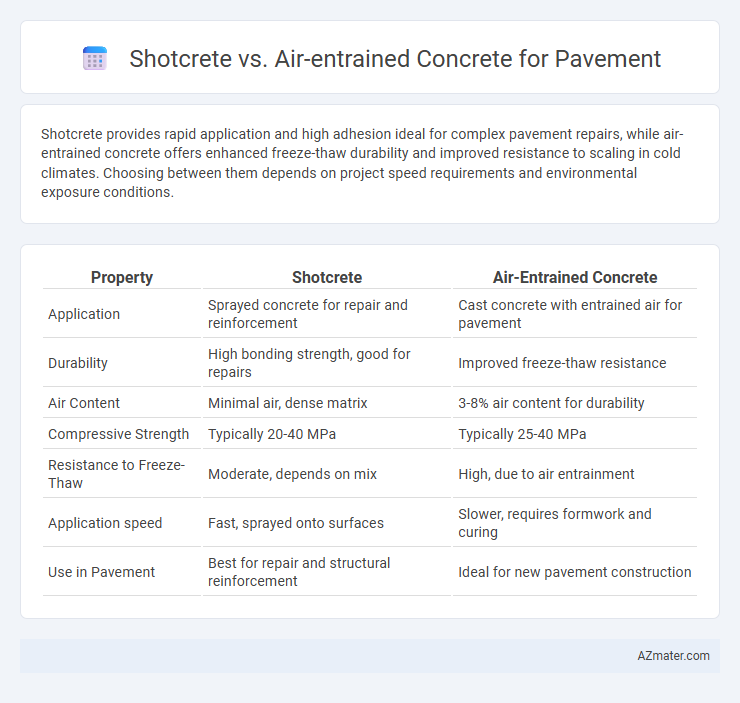Shotcrete provides rapid application and high adhesion ideal for complex pavement repairs, while air-entrained concrete offers enhanced freeze-thaw durability and improved resistance to scaling in cold climates. Choosing between them depends on project speed requirements and environmental exposure conditions.
Table of Comparison
| Property | Shotcrete | Air-Entrained Concrete |
|---|---|---|
| Application | Sprayed concrete for repair and reinforcement | Cast concrete with entrained air for pavement |
| Durability | High bonding strength, good for repairs | Improved freeze-thaw resistance |
| Air Content | Minimal air, dense matrix | 3-8% air content for durability |
| Compressive Strength | Typically 20-40 MPa | Typically 25-40 MPa |
| Resistance to Freeze-Thaw | Moderate, depends on mix | High, due to air entrainment |
| Application speed | Fast, sprayed onto surfaces | Slower, requires formwork and curing |
| Use in Pavement | Best for repair and structural reinforcement | Ideal for new pavement construction |
Introduction to Pavement Concrete Technologies
Shotcrete offers rapid application and superior adhesion for pavement repairs, utilizing pneumatically projected concrete to form dense, durable layers. Air-entrained concrete incorporates microscopic air bubbles to enhance freeze-thaw resistance and workability, making it ideal for pavements in cold climates. Both technologies improve pavement longevity, with shotcrete favoring localized repair and air-entrained concrete suited for full pavement construction.
Defining Shotcrete: Features and Applications
Shotcrete is a high-velocity concrete application method where a pneumatically projected mixture adheres to surfaces, used extensively for rapid repair and structural reinforcement in pavements. Its unique features include enhanced bonding strength, minimal formwork requirements, and adaptability to complex geometries, making it ideal for infrastructure projects like tunnel linings and slope stabilization. Shotcrete's superior durability and quick-setting properties enable efficient restoration and maintenance in heavy-traffic pavement environments.
Understanding Air-entrained Concrete: Key Properties
Air-entrained concrete contains microscopic air bubbles introduced during mixing, which improve freeze-thaw resistance and durability for pavement applications. These entrained air pockets reduce water absorption and minimize internal stress caused by temperature fluctuations, enhancing long-term performance. The key properties include increased workability, improved resistance to scaling, and better overall toughness compared to non-air-entrained shotcrete.
Comparative Strength and Durability
Shotcrete offers enhanced bonding and rapid application, providing superior compressive strength and excellent durability under dynamic loads compared to air-entrained concrete, which excels in freeze-thaw resistance due to its microscopic air bubbles. Air-entrained concrete's controlled air voids improve pavement longevity in cold climates by mitigating frost damage, while shotcrete's dense matrix resists abrasion and impact more effectively in high-traffic scenarios. Both materials deliver distinct advantages for pavement applications, with shotcrete favored for structural resilience and air-entrained concrete preferred for environmental durability.
Workability and Application Methods
Shotcrete offers superior workability for complex pavement repairs due to its high-velocity application process, allowing precise placement on vertical or overhead surfaces without formwork. Air-entrained concrete enhances freeze-thaw durability in pavements and requires traditional placement methods such as pouring and compaction, making it suitable for flat, horizontal surfaces. The choice between shotcrete and air-entrained concrete depends on site conditions and project-specific application needs for optimal pavement performance.
Performance in Harsh Weather Conditions
Shotcrete offers superior adhesion and durability on irregular surfaces, enhancing performance in harsh weather by resisting freeze-thaw cycles and preventing water infiltration. Air-entrained concrete improves pavement resilience through microscopic air bubbles that relieve internal pressure from freezing moisture, reducing cracking and scaling in cold climates. Both materials enhance pavement longevity, but shotcrete's rapid application and dense matrix provide exceptional protection against environmental stresses.
Cost-effectiveness and Material Efficiency
Shotcrete offers superior cost-effectiveness for pavement repair due to reduced formwork and labor requirements compared to traditional air-entrained concrete. Material efficiency in shotcrete is enhanced by precise application techniques that minimize waste and provide strong adhesion, whereas air-entrained concrete requires strict mixing controls to maintain durability and freeze-thaw resistance. Evaluating project scale, accessibility, and environmental conditions is critical in selecting the most economical and efficient material for pavement construction.
Maintenance and Longevity Considerations
Shotcrete offers rapid application and strong adhesion for pavement repairs, enhancing durability in localized areas with minimal surface preparation. Air-entrained concrete improves freeze-thaw resistance by incorporating microscopic air bubbles, significantly extending pavement lifespan in cold climates through reduced cracking and scaling. Maintenance demands for air-entrained concrete are generally lower due to its enhanced durability, while shotcrete may require periodic inspections to address potential surface wear and rebound areas.
Environmental Impact and Sustainability
Shotcrete offers a sustainable alternative for pavement repair by reducing construction time and minimizing waste through precise application, which lowers overall environmental impact compared to traditional methods. Air-entrained concrete enhances durability and resistance to freeze-thaw cycles, extending pavement lifespan and reducing the frequency of repairs, thereby conserving resources and energy over time. Both technologies contribute to sustainable pavement solutions, with shotcrete optimizing material use and air-entrained concrete improving long-term performance and resilience.
Selecting the Right Option for Pavement Projects
Shotcrete offers rapid application and high bond strength, ideal for complex pavement repairs and overhead surfaces, while air-entrained concrete provides superior freeze-thaw durability essential for outdoor pavements in cold climates. Selecting the right option depends on project-specific factors such as environmental exposure, structural demands, and application speed requirements. Evaluating factors like frost resistance, load-bearing capacity, and onsite application constraints ensures optimal pavement performance and longevity.

Infographic: Shotcrete vs Air-entrained Concrete for Pavement
 azmater.com
azmater.com